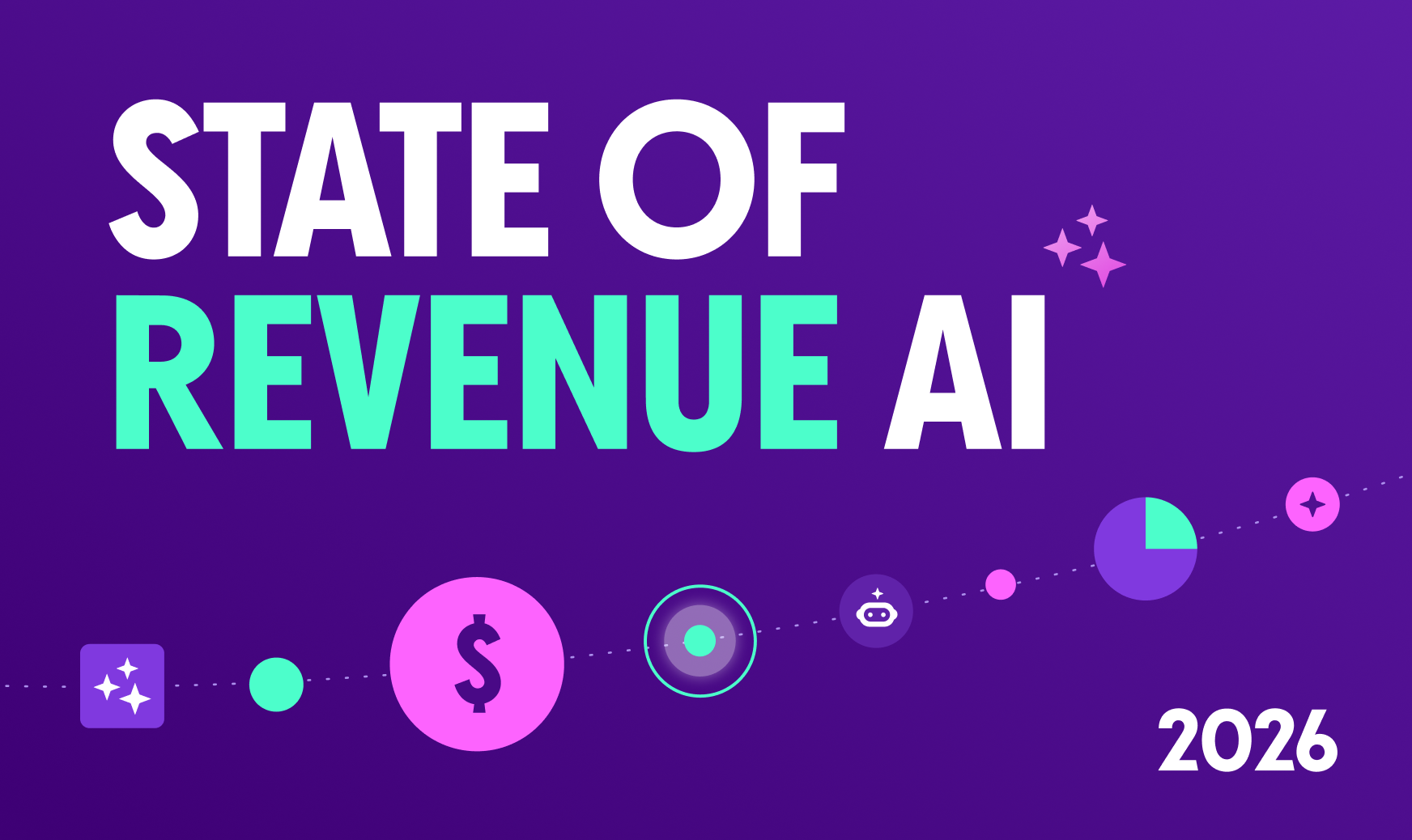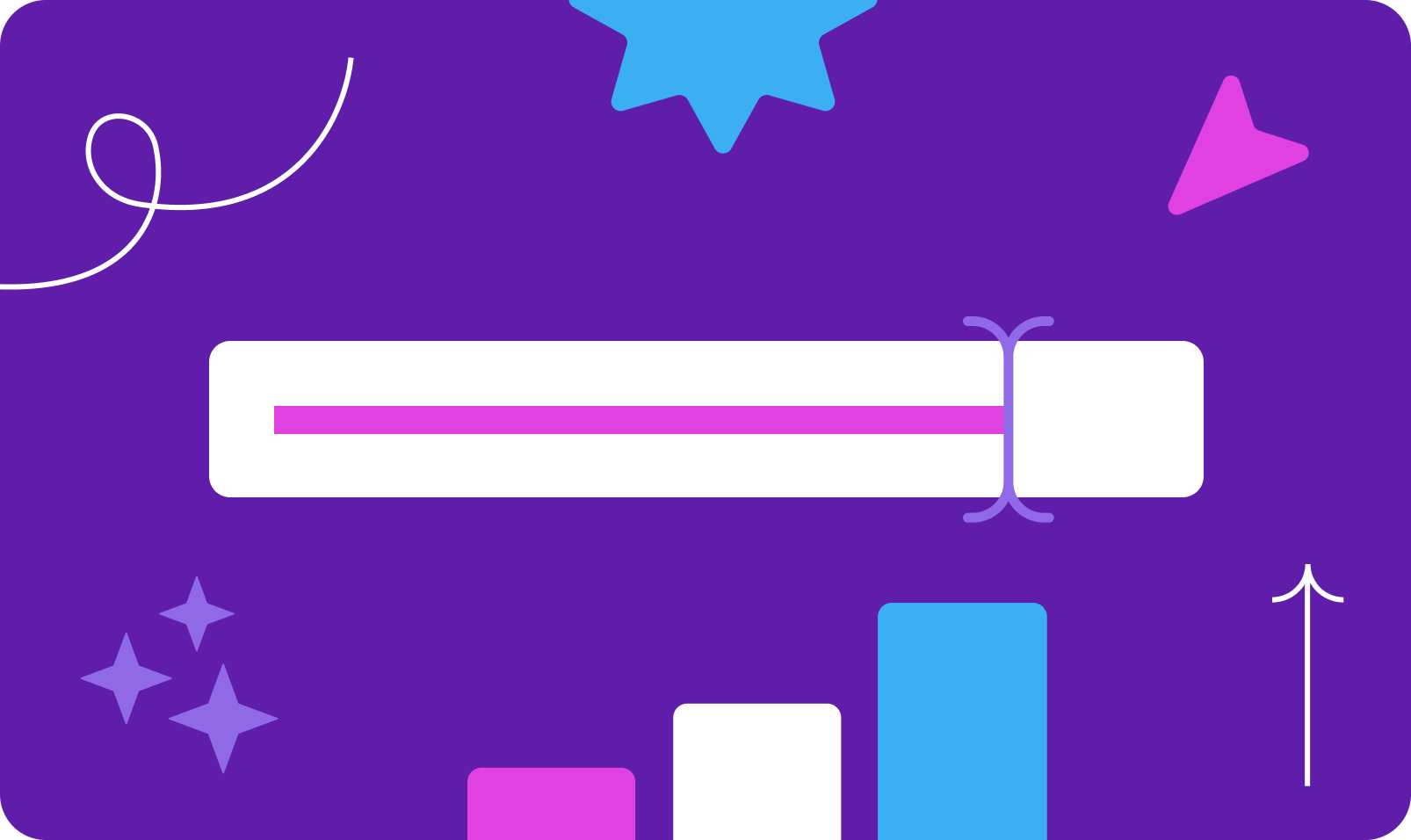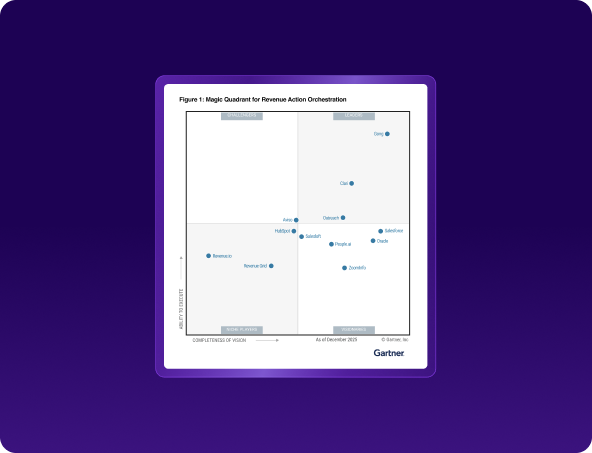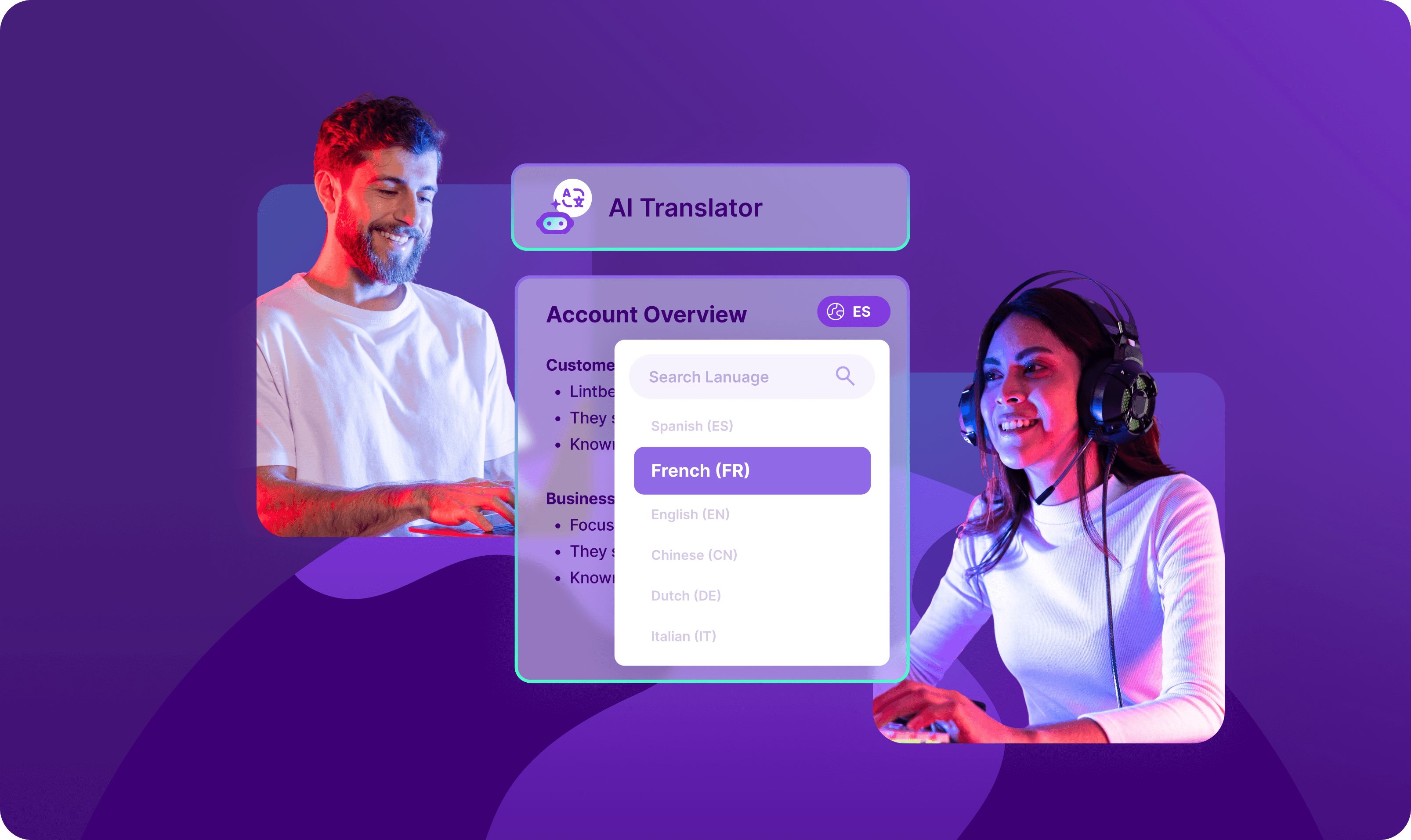Your guide to sales performance management software

Dan Morgese
Director, Content Strategy and Research at Gong
Published on: June 27, 2025
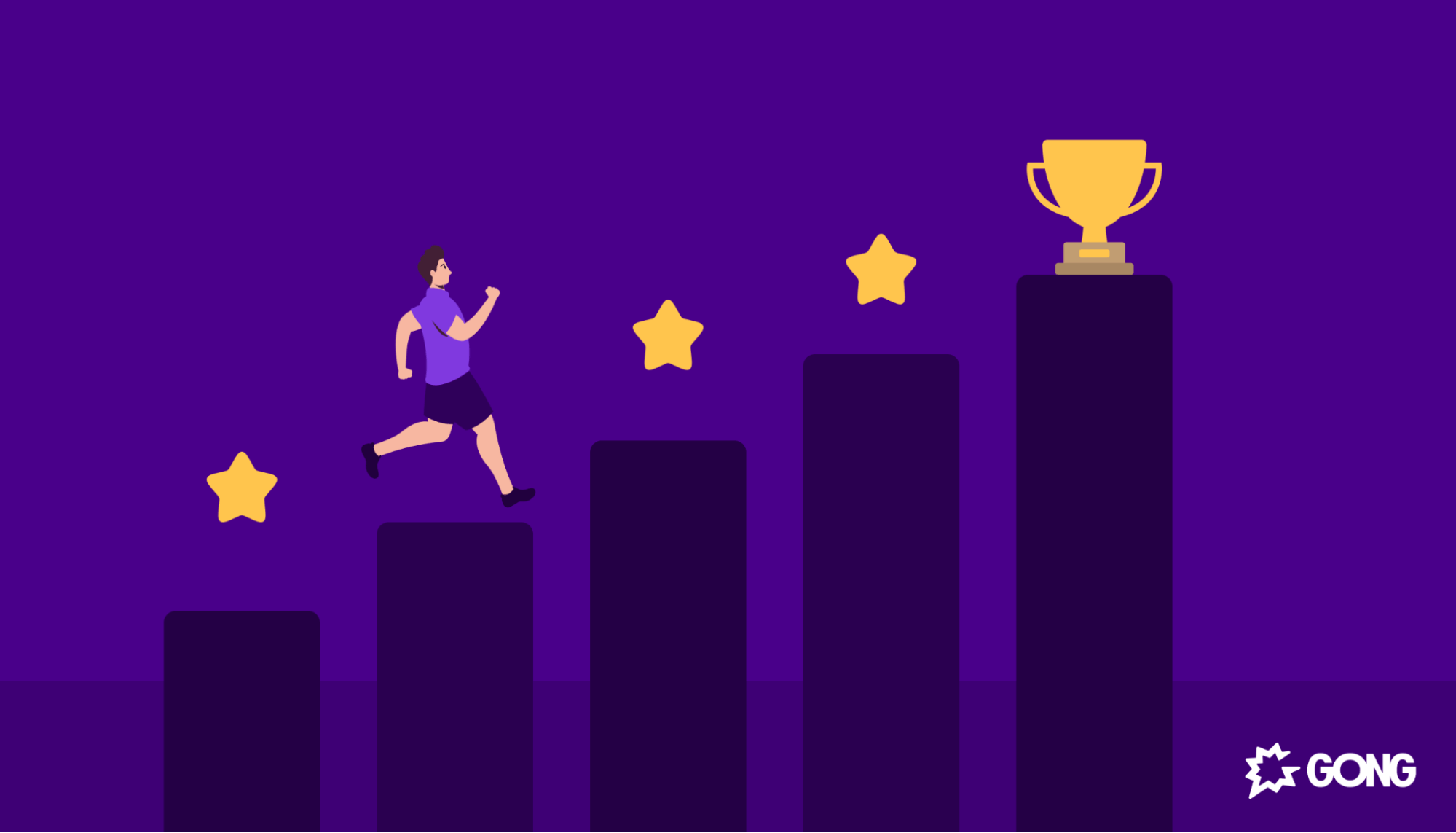
Every sales team has its superstars.
That in itself is nothing to worry about. But when there’s a wide gap between your best reps and the rest of the team, that can spell trouble. You’ve tried everything — coaching, incentives, getting your top reps to their secrets — but the rest of the team just isn’t hitting quota.
What if you miss your targets?
Well, it doesn’t have to come to that. By implementing your chosen sales performance management software, you can use data to turn things around. This software tracks and analyzes your team’s performance, revealing the strategies that your best reps use. With these insights, you can coach the entire team to success.
In this article, we’ll explore how sales performance software can help you close the performance gap and hit your numbers.
Why should companies use sales performance management software?
You can’t improve what you don’t measure, and if you’re not tracking key metrics, you won’t have a baseline to work from.
It’s going to be hard to really coach your reps on ways to improve if there’s nothing that you can track and say like, ’Oh, your emails are actually not converting. Let’s look into that,’ or ‘Oh, your call connects are high, but why aren’t those converting into opportunities? Let’s just do some more mock calls or coaching sessions there.’ The risk there is not being able to coach effectively and being targeted.
"It's going to be hard to really coach your reps on ways to improve if there's nothing that you can track and say like,'Oh, your emails are actually not converting. Let's look into that,' or 'Oh, your call connects are high, but why aren't those converting into opportunities? Let's just do some more mock calls or coaching sessions there.' The risk there is not being able to coach effectively and being targeted."
That’s where sales performance management software comes in. It gives you the data you need to coach with precision. Here’s how:
Keep your forecasts accurate
Sales forecasting, while vital, is notoriously difficult to get right.
Only a quarter of sales organizations achieve a forecast accuracy of 75 percent or higher. Why? Many companies rely on gut instincts and past experience instead of data to evaluate their deals. This simply isn’t a reliable approach.
A better solution is to use sales performance management software. It helps you create more accurate forecasts by analyzing historical data and market trends, spotting risks to your deals, and identifying opportunities for sales.
With more reliable forecasts, you can:
- Prioritize deals appropriately
- Set realistic sales goals
- Plan budgets
- Allocate resources more effectively
Plus, it helps you manage inventory and fine-tune your marketing strategy.
Monitor your team’s performance in real time
Historical data shows how much revenue each salesperson generated and the length of their sales cycle, but it doesn’t reveal their current performance inside active accounts. For that, you need real-time insights — exactly what sales performance management solutions deliver.
Let’s say your rep has just wrapped a prospecting call. With real-time performance tracking, you can immediately jump in, address issues or highlight new opportunities.
You’ll also know when someone is struggling, and be able to offer targeted coaching. When you see what your top performers are doing right, you can those behaviors across the team. What’s more, real-time data lets you adjust your goals as needed, keeping your team focused and on track to hit their targets.
Build a better pipeline
Let’s say a rep is making plenty of calls and covering the right topics, but only a small number of their deals convert and close. What’s going on? Maybe they’re targeting the wrong prospects, or maybe they’re not connecting your product’s value with the buyer’s pain effectively. Without data, it’s hard to know for sure.
Sales performance software lets you monitor your reps’ customer interactions and ensure that deals are moving through each stage without issues. If a deal stalls in the proposal stage, for example, you can spot it quickly and implement strategies to keep things moving.
It also helps you gauge which deals are most likely to close, giving you better control over your forecast and ensuring a steady flow of deals.
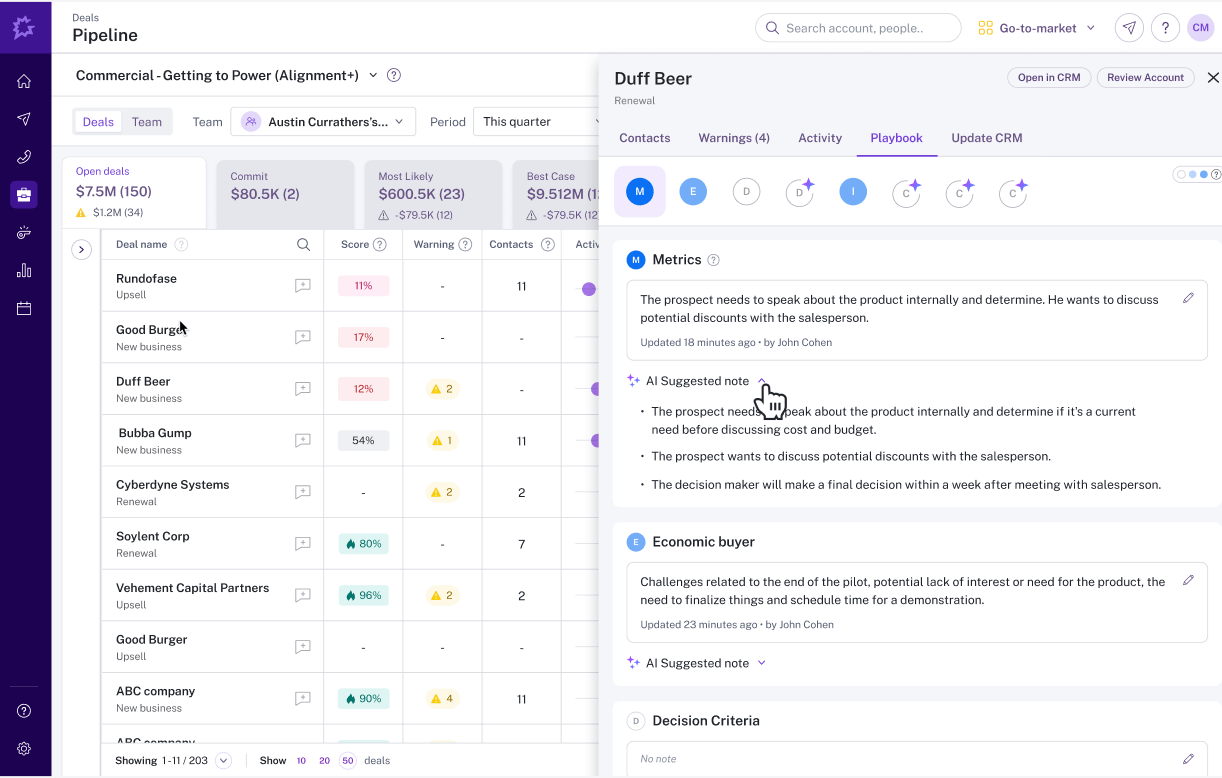
( Image Source )
Manage your territories and quotas
Striking the right balance between territories and quotas can make or break your sales team’s success. But without a sales performance management solution, you’re stuck manually creating them, which is both an error-prone and time-consuming approach. What if you get it wrong?
Well, you don’t have to.
Performance management software analyzes factors like past data, customer demographics, and market potential. It helps you find areas with the highest potential and those that are doing poorly. You can then adjust your team’s territories and quotas as market conditions change or as your reps’ performance evolves.
Plus, this software can match reps to the right territories based on their skills and experience while keeping their workload manageable.
Create motivating incentive compensation plans
At the top-performing sales organizations, almost half — 49 percent — of sales representatives believe their compensation packages are fair. At other organizations, only 30 percent feel the same way. When people feel like they aren’t being compensated properly, they aren’t motivated to sell.
With sales performance management software, you can create incentive plans that go beyond quota attainment. For example, a tiered bonus system can reward reps for exceeding goals or selling high-margin products.
How do you keep the packages fair? The software takes care of that as well. It automates incentive calculations based on performance data, removing biases altogether.
What to look for in sales performance management software
There are plenty of sales performance management software options on the market today. To choose the right one for your needs, here are the key features to look for:
Comprehensive analytics and reporting
Your chosen software should provide detailed analytics and customizable reports.
These tools let you dive deep into performance metrics, making it easy to spot where your team can make improvements. For example, you might discover that certain reps struggle with closing deals or maintaining momentum during sales calls. With this information at hand, you can offer targeted coaching.
Goal setting and tracking
To keep your sales team focused and aligned with company objectives, you need software that supports clear goal setting and real-time tracking. The right solution helps you set ambitious yet realistic targets and monitor your team’s progress as it happens. This keeps everyone on the same page and allows you to quickly regroup if your team strays from their goals.
Real-time performance monitoring
Real-time dashboards and performance tracking are crucial in any sales performance software. They provide immediate insights into your team’s sales activities, letting you address issues or seize opportunities as they occur. This means you won’t be caught off guard and can quickly make adjustments to keep your sales strategy on track.
Predictive analytics
Predictive analytics are one of the most powerful tools a sales performance management solution can offer. When it comes to deals, it should do three things:
- Provide data throughout the sales process to help prioritize deals and clarify which ones are worth pursuing
- Warn you of at-risk deals and tell you how to address them before they’re lost
- Use historical data to identify the factors behind won deals so you can strategize with your team
Also look for software that spots early signs of customer churn, so reps have a chance to resolve issues before clients leave.
Incentive and compensation management
Managing complex incentive and compensation plans can be challenging, but your chosen solution should simplify the process.
Look for software that automates incentive calculations and allows you to customize plans as needed. Whether it’s changing a bonus structure or creating new incentives, the right software should let you be creative without making the process more complicated.
Integration capabilities
Do your reps spend more time juggling tools than selling? Or worse, do they spend it hunting for critical data?
To prevent this from happening, choose software that integrates with your existing systems, whether it’s your CRM, ERP, or other business systems. Integrating your software — and your data — saves time, cuts down on data errors, and makes it easier for your reps to focus on winning deals.
Scalability
Your business is going to grow, and your software should grow with it. Ensure that the platform you choose can handle increasing data volumes and adjust to the growing demands of your sales team as your business expands.
How can sales performance management software help your team hit quotas?
Sales teams that consistently hit their quotas don’t just rely on hard work. They have the right tools in place, and sales performance management software is one of the most important ones in their toolkit. Here’s how it can make a difference:
Set realistic and data-driven quotas
Setting ambitious targets is tempting, but can your team actually meet them? On average, B2B sales teams hit just 47 percent of their quotas, often because the targets are too high.
Sales performance software helps you avoid this by using historical data, market trends, and predictive models to set quotas that are both realistic and achievable. Instead of guessing, you’ll use accurate data to set quotas. This will give your team a better chance to reach or even exceed their targets without being overwhelmed.
Spot performance problems early
If you’re waiting until the end of the quarter to address performance issues, you’re already behind. To stay competitive, you need to tackle problems as soon as they arise. That’s where sales performance software gives you the edge.
With real-time insights, dashboards, and reports, you can catch underperformance early — whether it’s a rep or an entire region — and act before it impacts results. For example, if a region isn’t delivering, you might choose to adjust sales territories and focus your efforts on more promising areas. This gives your team a better chance to meet their targets.
Provide coaching and development
Sales performance management software often includes tools that identify skills gaps and offer personalized coaching or training modules. Take Gong, for instance. Gong’s Deal Boards, Smart Trackers, call recording, and AI features provide sales managers with the data they need to coach each rep where it matters most.
By zeroing in on areas that need improvement, managers can help reps sharpen their skills and close more deals. In turn, reps can hit their quotas more consistently.
Send early warning alerts
Do you know when a rep is falling behind on their quota? Or when key metrics, like lead conversion rates, are starting to slip? Don’t wait until it’s too late. Set up alerts with sales performance software to catch these issues early.
Platforms like Gong even offer deal warnings when data shows a deal is at risk, with alerts like “no activity,” “ghosted,” or “pricing not mentioned.” These warnings let you act fast, whether it’s reallocating resources, adjusting your strategy, or offering extra support to keep deals and quotas on track.

( Image Source )
Optimize time and resource allocation
You’ve set the budget — now it’s time to ensure your team is maximizing their time and resources.
Sales performance software analyzes data to highlight high-potential opportunities, guiding reps to focus on the best leads and territories. This lets your sales reps work smarter, not harder, increasing their chances of closing deals and hitting quotas.
Streamline the sales process
If your reps struggle to hit their quotas, inefficiencies in your sales process might be the cause. Bottlenecks or time-wasting tasks that keep reps from spending their timesellingare common culprits. You can use sales performance solutions to identify and automate many of their manual tasks.
With fewer distractions, your team can focus on closing deals and moving through the pipeline, getting them closer to hitting quotas.
Common challenges in implementing sales performance management software
Sales performance management software can deliver major improvements, but implementing it comes with its own set of difficulties. From getting the system up and running to securing team buy-in, here are some common obstacles and ways to overcome them.
Getting your team to adopt the software
With nearly half of salespeople feeling overwhelmed by the amount of technology they have to use, it’s no surprise that those who struggle with tech are 43 percent less likely to hit their quotas. If your team clings to their old tools or doesn’t quite “get” the new software, they’ll miss out on all its benefits. That means less performance improvement and fewer valuable insights.
Solution: Invest in training programs, create easy-to-follow guides, and offer incentives that motivate your team to use the software consistently.
Data accuracy and quality
Your software is only as good as the data it uses. Poor data quality, missing information, or inconsistent input can undermine its value. When your data isn’t accurate, it’s not reliable and neither are your performance metrics. That means flawed decisions follow.
Solution: Implement strong data governance to keep everything in check. Clean up your current data, train your team on accurate data entry, and automate repetitive tasks to reduce human error and save time.
Integration with existing systems
One of the biggest implementation challenges is integrating new software with your current systems. Without proper integration, you risk creating data silos, duplicating entries (or errors), and introducing inefficiencies that reduce the software’s effectiveness.
Solution: Choose a solution that integrates well with your tech stack. Work closely with your IT team and the software vendor to plan and test integration points to ensure frictionless data flow between systems.
Customizing the software to fit your needs
Tailoring the software to match your business processes, compensation plans, and reporting needs isn’t always easy. Over-customizing can lead to errors, misaligned processes, and higher costs, while under-customizing may result in a poor fit with your operations.
Solution: Striking the right balance is crucial. Focus on customizing only what directly supports your business goals. Keep things as simple as possible, and make sure to test thoroughly before going live to avoid potential issues later on.
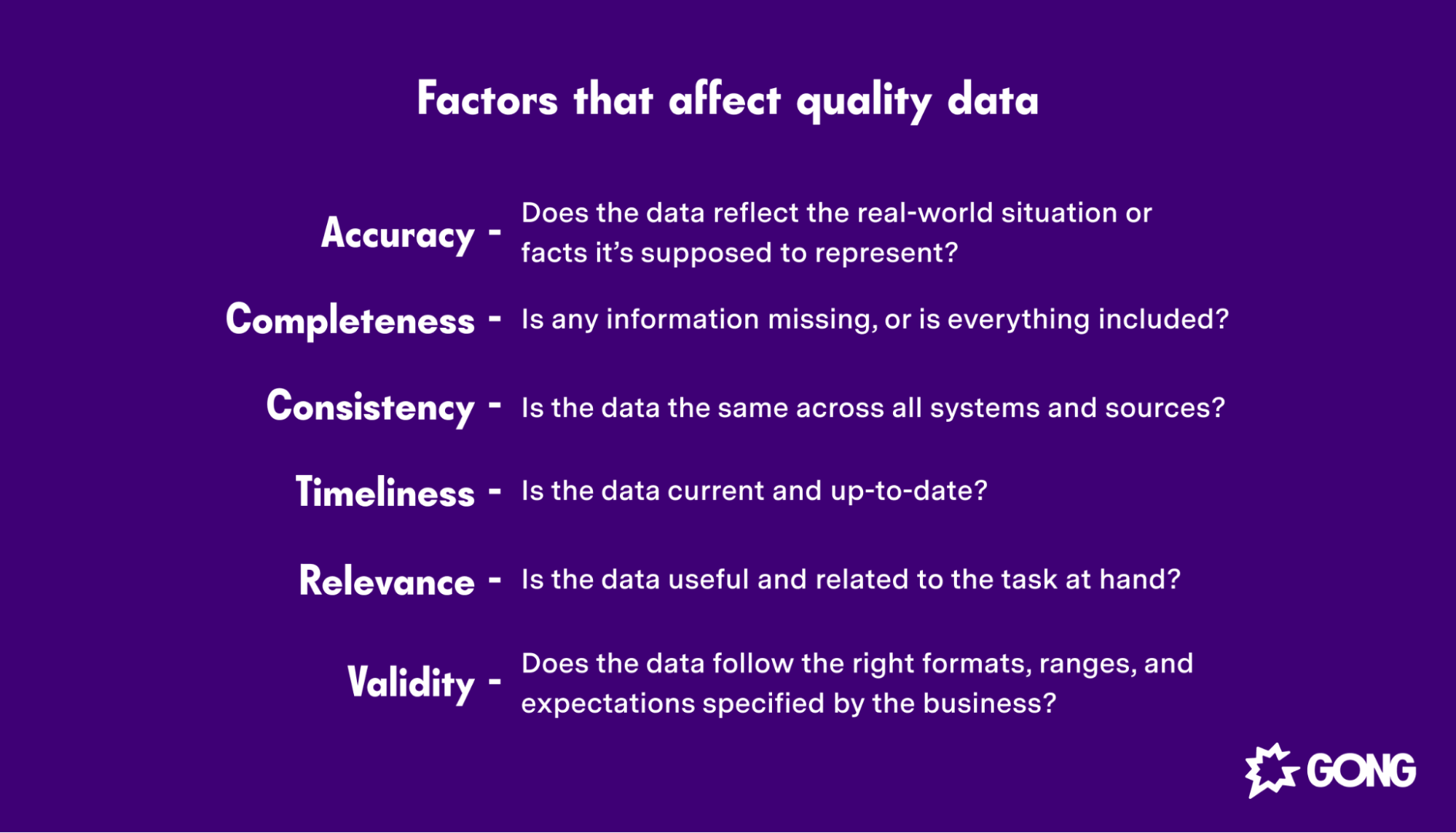
How might sales performance management software evolve?
As technology advances, so will the capabilities of sales performance management software. Here’s a look at some future trends that could reshape how sales teams reach their targets.
Increased use of artificial intelligence (AI) and machine learning (ML)
AI and ML are becoming must-haves in sales performance software for their ability to provide predictive insights and automate routine tasks. In fact, 52 percent of sales professionals already rely on AI.
That’s because AI and ML enable software to:
- Analyze past data
- Scan call summaries
- Predict the likelihood to buy
- Identify market trends
- Generate accurate forecasts
Looking ahead, AI could even predict which reps will exceed their quotas and offer real-time suggestions to help underperforming reps adjust their focus or territories.
Improved predictive analytics
Predictive analytics will play an even bigger role in how sales teams work by forecasting:
- Sales trends
- Customer behaviors
- Potential risks
This will enable sales teams to anticipate changes and make proactive adjustments to stay ahead of market shifts.
Hyper-personalized sales strategies
No two salespeople, customers, or deals are the same, so a one-size-fits-all approach just doesn’t cut it. That’s why sales performance software is moving toward hyper-personalized strategies.
Ideally, this software creates custom guidance to improve close rates by studying each rep’s strengths, customer preferences, and deal details. Gong is already doing this. For example, a sales rep might receive automated tips on which product features to emphasize based on a customer’s previous interactions or purchasing behavior.
Automated goal setting and quota adjustments
Getting a better picture of reality is one thing, but adjusting to it quickly can be a challenge. That will change soon thanks to the inclusion of real-time data and AI in sales performance management software.
In future scenarios, it could automatically shift your sales goals and quotas based on:
- Market conditions
- Team performance
- Economic changes
- New product launches
These automated adjustments would keep targets realistic and achievable, allowing for better sales outcomes and less stress on reps.
Real-time collaboration and social features
According to McKinsey, the future of sales is hybrid. Hybrid reps already account for 50 percent of sales teams in financial services, energy, and materials. They also make up over 45 percent in the high-tech and consumer sectors, and these numbers are only expected to grow.
Because of this, sales performance software is already evolving to include real-time collaboration and social features that allow your team to:
- insights
- Discuss strategies
- Troubleshoot in real time
Instead of using tools like Slack or email, sales reps will be able to deal updates, best practices, and strategies directly within the platform. In fact, this is already possible in an advanced solution like Gong.
How using Gong can help you hit your targets
Hitting your sales and revenue targets is much easier when you’re equipped with the right tools. In fact, 48 percent of top sales teams use technology to their advantage, compared to just 27 percent of other sales teams. Here’s how Gong can help get you there:
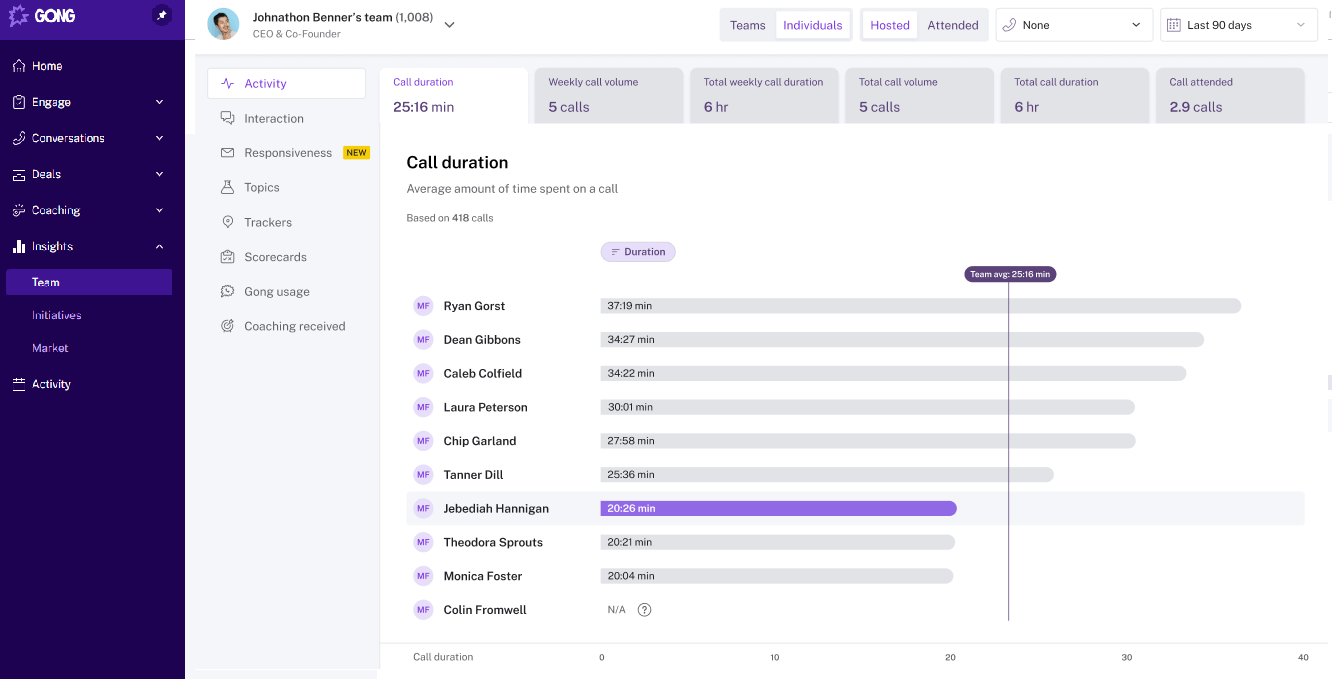
( Image Source )
Predict which deals will close
Gong Forecast analyzes over 300 data points in its Deal Likelihood Score to predict which deals are most likely to close. These AI-powered predictions are 20 percent more accurate than CRM data alone and 22 percent more reliable than a sales rep’s predictions. What’s more, Forecast notes whya deal is likely (or unlikely) to close so your team can prioritize better.
See everything in one place
Say goodbye to constant tool switching. Gong Engage lets you track all your accounts and monitor your sales reps’ performance in one convenient platform. Everything from prospecting to conversion rates and email performance is easily accessible, making it easy to stay on top of your team’s progress.
Provide personalized coaching
With Gong, you’ll know exactly where each sales rep shines and where they need support — whether it’s specific skills, behaviors, or sticking to sales processes. The platform evaluates these areas and provides data-driven recommendations, allowing managers to deliver personalized coaching programs for each rep.
Wondering if your managers are doing enough coaching? Keep them accountable by tracking coaching activity in Gong. It will tell you, for example, if they’re listening to enough calls or providing enough feedback.
Integrate with your existing tech stack
Gong integrates with a wide range of tools across the sales process, making it easy to fit into your current tech stack. For performance management, it connects with platforms that include:
- Lessonly
- Enable Us by Mindtickle
- EverAfter
- Proposify
- Zelta.ai
- Rattle
- Aircall
- Ambition
- Atrium
- Brainshark
- Domo
- E4enable
- Adiyo
- Poised
- Rhythm
- Scribe
- Fabius
- Flockjay
- GTM Buddy
- Op Tonal
By combining Gong with the tools you already use, you can boost your team’s efficiency without disrupting your workflow.
Find out what’s working… and what’s not
Want to know what your customers are really saying? Gong offers a snapshot of all customer conversations, tracking things like the frequency of new topics, product requests, and competitor mentions. This helps you quickly see what’s resonating and what needs improvement.
Gong also automatically updates your CRM, improving visibility across teams and reducing manual data entry errors. And with detailed reports, you’ve got the data you need to make smart, informed decisions.
Close the performance gap with Gong
Let’s face it, not all of your reps are superstars. Even with the best sales performance management software, some will naturally sell better than others. But that’s okay.
Not everyone can be your top performer, but there’s always room for improvement. Maybe a rep isn’t hitting key topics enough or is overusing certain keywords. Another might talk too much during customer calls when they should listen. Sometimes, it’s not even the reps’ fault — maybe the sales map boundaries are off, and that’s why you’re missing targets.
Without data, you’ll never truly know where improvements are necessary. With Gong, you get a reality-based picture of your team’s soft skills and deal execution, so you can quickly spot problem areas and close those crucial skills gaps.
Don’t leave your team’s performance to chance. Book a demo today.

Director, Content Strategy and Research at Gong
For over a decade, Dan has provided revenue leaders with data and insights to inform and execute their GTM strategies. As a former analyst at Forrester Research, he worked with hundreds of B2B organizations to measure and improve sales productivity.
Discover more from Gong
Check out the latest product information, executive insights, and selling tips and tricks, all on the Gong blog.
